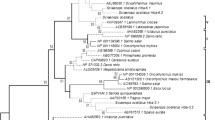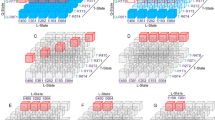Abstract
Over the years, a considerable body of evidence has accumulated which shows that fish hemoglobins not only differ from mammalian hemoglobin, but also differ greatly from one another (1,2,3). A large amount of work is involved in characterizing the function of a hemoglobin in detail so relatively few have been studied fully. It seems, however, that there may be three general classes of fish hemoglobins. These are first, the Root effect hemoglobins, in which one chain has a very low affinity for ligand in the T-state, and which show a marked change in affinity with pH (4). Second, and coexistent in the same fish with the Root effect hemoglobins, are the pH invariant and effector independent hemoglobins, studied first by Hashimoto and Matsuura (5) and since examined in great detail here in Rome as trout 1. The third group includes the shark hemoglobins which are cooperative, have chains which are alike in the T-state, and respond only moderately to pH change and to effectors (6,7,8). In looking for an explanation of this functional diversity it is natural to think first of the transport function of hemoglobin in fishes. There is, however, a good deal of evidence to suggest that many fishes can manage quite well without it.
Access this chapter
Tax calculation will be finalised at checkout
Purchases are for personal use only
Preview
Unable to display preview. Download preview PDF.
Similar content being viewed by others
References
A. Krogh and I. Leitch The respiratory function of the blood in fishes, J. Physiol. (London) 52: 288 (1919).
C. Prosser and F. A. Brown, “Comparative Animal Physiology,” 2nd Ed., Saunders, Phila., PA (1961).
A. Riggs, Properties of Fish Hemoglobins, in Vol. 4, p. 209, “Fish Physiology,” W. S. Hoar and D. J. Randall, eds., Academic Press, N.Y. (1970).
R. Root, The respiratory function of the blood of marine fishes, Biol. Bull. 81: 307 (1931).
K. Hashimoto and F. Matsuura, Comparative studies on two hemoglobins of salmon. IV. Oxygen dissociation curve, Bull. Japan Soc. Sci. Fish. 26: 827 (1960).
C. Albers and K. Pleschka, Effect of temperature on CO2 transport in elasmobranch blood, Res. Physiol, 2: 261 (1967).
M. Dickinson and Q. H. Gibson, Functional properties of the hemoglobin of the porbeagle shark, Biochem. J. (London), (1981) In press.
R. R. Penelly, R. W. Noble and A. Riggs, Equilibria and ligand binding kinetics of hemoglobins from the sharks Prionace glauca and Carcharhinus milberti, Comp. Biochem. Physiol. 52: 83 (1975).
M. Nicloux, Action de l’oxyde de carbone sur les poissons et capacite respiratoire du sang de ces animaux, Compt. Rend. Soc. Biol. 89: 1328 (1923).
J. Schlicher, Vergleichende physiologische Untersuchungen der Blutkörperchenzahlen bei Knochenfischen, Zool. Jahrb. 43: 121 (1927).
J. T. Ruud, Vertebrates without erythrocytes and blood pigment, Nature (London) 73: 848 (1954).
D. J. Randall, Gas exchange in fish, in Vol. IV, p. 253, Fish Physiology, W. S. Hoar and D. J. Randall, eds., Academic Press, NY (1970).
D. J. Randall, The circulatory system, in Vol. IV, p. 133, Fish Physiology, W. S. Hoar and D. J. Randall, eds., Academic Press, NY (1970).
F. G. Carey. Unpublished observations.
F. G. Carey and Q. H. Gibson, Reverse temperature dependence of oxygenation of tuna hemoglobin, Biochem. Biophys. Res. Commun. 78: 1376 (1977).
F. G. Carey and K. D. Lawson, Temperature regulation in free-swimming bluefin tuna, Comp. Biochem. Physiol. 44A: 375 (1973).
A. Rossi-Fanelli and E. Antonini, Oxygen equilibrium of hemoglobin from Thunnus thynnus, Nature (London), 186: 895 (1960).
M. F. Andersen, J. S. Olson, Q. H. Gibson and F. G. Carey, Studies on ligand binding to hemoglobins from teleosts and elasmobranchs, J. Biol. Chem. 248: 331 (1973).
R. Fänge, Physiology of the swimbladder, Physiol. Rev. 46: 299 (1966).
J. B. Wittenberg and B. A. Wittenberg, The choroid rete mirabile of the fish eye. I. Oxygen secretion and structure: Comparison with the swimbladder rete mirabile, Biol. Bull. 146: 116 (1974).
Author information
Authors and Affiliations
Editor information
Editors and Affiliations
Rights and permissions
Copyright information
© 1982 Plenum Press, New York
About this chapter
Cite this chapter
Gibson, Q.H., Carey, F.G. (1982). The Function of High Hemoglobin in Large Fish. In: Bossa, F., Chiancone, E., Finazzi-Agrò, A., Strom, R. (eds) Structure and Function Relationships in Biochemical Systems. Advances in Experimental Medicine and Bioligy, vol 148. Springer, Boston, MA. https://doi.org/10.1007/978-1-4615-9281-5_5
Download citation
DOI: https://doi.org/10.1007/978-1-4615-9281-5_5
Publisher Name: Springer, Boston, MA
Print ISBN: 978-1-4615-9283-9
Online ISBN: 978-1-4615-9281-5
eBook Packages: Springer Book Archive




